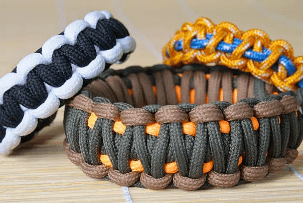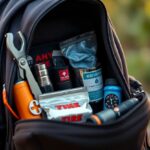A survival paracord bracelet is a compact, wearable way to carry useful cordage. Most are made from 550 paracord, a nylon cord with a braided outer sheath and several inner strands. The finished bracelet looks like a woven band but can be quickly unraveled to produce several feet of usable cord and fine inner threads for small tasks. Common weaves include the cobra (Solomon) knot, fishtail, and king cobra (double cobra). Benefits: lightweight, always on your wrist, versatile in outdoor and emergencies.
Key Takeaways:
- A survival paracord bracelet is a wearable length of 550 paracord woven into a bracelet that can be unraveled to provide strong emergency cordage.
- Common uses include shelter building, splints, fishing line (inner strands), snares, lashing, and improvised repairs.
- Typical components are 550 paracord (outer sheath + inner strands), a buckle or shackle, and basic tools (scissors, lighter).
- For a standard cobra weave, a rough rule of thumb is about 1 foot (30 cm) of cord per finished inch of bracelet; a 7" wrist ≈ 7–8 ft (2.1–2.4 m) of cord.
- Finish by tightening knots, trimming excess, and melting ends to prevent fray; inner strands can be removed for fine tasks.
What is it Ecaxtly
A survival paracord bracelet is a compact, wearable source of strong nylon cord (usually military-spec 550 paracord). It’s woven into a band for everyday carry; when needed, the weave is unraveled to supply several meters of cord and inner strands for multiple field uses.Materials and tools
- 550 paracord (length per rule of thumb above)
- Buckle, metal shackle, or loop-and-knot closure
- Scissors or a sharp knife
- Lighter or heat source to melt ends
- Ruler or tape measure
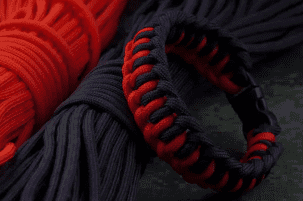
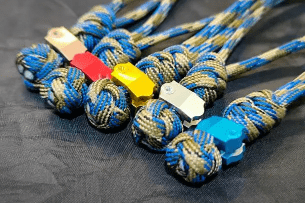
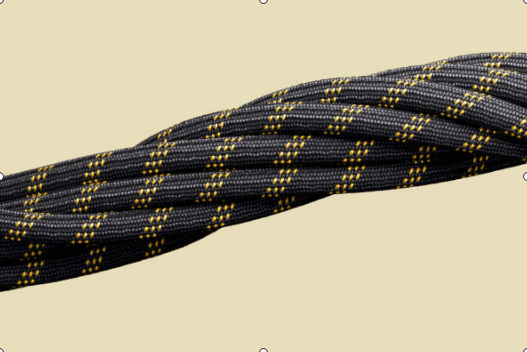
How to make a basic cobra‑weave survival paracord bracelet
- Measure wrist: wrap measuring tape around wrist where bracelet will sit. Add 1/2–1" (1–2 cm) for comfort.
- Calculate cord length: use ~1 ft (30 cm) of paracord per finished inch. Example: 7" bracelet → 7–8 ft (2.1–2.4 m) of cord. If using two colors or styles, split accordingly.
- Fold the cord in half to find the midpoint. Thread midpoint through one side of the buckle to create a lark’s head (or loop through the shackle) so two working strands run to the other buckle half.
- Attach the other buckle half to the free ends, set the bracelet length by clipping the buckle halves together, and align with your wrist measurement.
- Make the cobra knots: with the left cord, pass it over the two center strands and under the right cord; bring the right cord under the center strands and up through the loop on the left; tighten. Repeat mirrored: start with the right cord next. Continue alternating until you reach the end of the buckle.
- Finish the ends: pull knots snug and even. Trim excess cord, leaving a few millimeters. Melt trimmed ends with a lighter and press slightly to seal; tuck melted ends into nearby weave if possible.
- Test fit and adjust: unclasp and wear to ensure comfort; if too tight/loose, remake using a slightly different base length.
Practical tips
- Inner strands (the fine fibers inside the sheath) can be pulled out for sewing, fishing line, or tinder cord.
- Use a small rod or fid to push melted ends into the weave neatly.
- Experiment with different weaves (king cobra, fishtail, Solomon) for extra cord or different looks; these change cord requirements.
What is Paracord?
Paracord, short for parachute cord, is a lightweight nylon kernmantle rope developed in the 1940s for parachute suspension lines; you’ll most commonly encounter Type III or "550" paracord rated at 550 lb tensile strength. You can unravel the braided sheath to access inner strands for fishing line, sewing, or snare material, but do not use paracord for climbing or other certified load-bearing applications—its strengths lie in versatility, compactness, and emergency utility.
Composition and Strength
Paracord consists of a braided outer sheath (mantle) and a core of typically 7–9 inner strands, each made of multiple yarns; Type III (550) combines elasticity and abrasion resistance from nylon fibers and delivers a reliable 550 lb break strength. You’ll notice sheath damage or kinks sharply reduce overall strength, and chemical exposure or UV can weaken nylon over time, so inspect your cord before relying on it.
Historical Uses
Originating in WWII, paracord came from parachute suspension lines and soldiers quickly repurposed it for gear repair, improvised shelters, and lacing boots; by the late 20th century civilians and survival communities turned surplus cord into everyday tools and the modern survival bracelet. You’ll find paracord in vintage military kits and contemporary outdoor packs because of its proven field utility and the life‑saving improvisations it enabled in combat and wilderness scenarios.
Field examples include using paracord as a tent ridge line, replacing snapped bootlaces, fashioning slings or splint bindings, and extracting inner strands for fishing leaders or lightweight suturing thread in extreme emergencies—procedures that can be lifesaving yet carry risk if misapplied. You should treat paracord as an emergency resource: use inner strands for fine work and avoid improvising critical medical or load-bearing solutions without proper training.
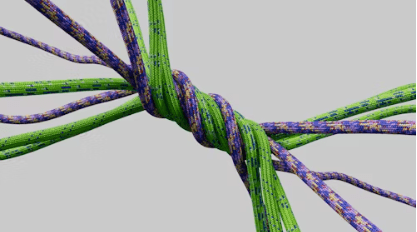
Purpose of a Survival Paracord Bracelet
You wear the bracelet so you always have 8–10 feet of cord at hand; many bracelets use Type III paracord, with a 550 lb rated tensile strength. The compact wrap keeps the cord accessible for rapid deployment—unraveling gives you a versatile length for lashing, repairs, or improvised gear. You can stash an average bracelet under clothing or on a pack for immediate use without added bulk.
Practical Applications
Common practical tasks include shelter lashing, gear repair, and replacing broken shoelaces; a single bracelet yields enough cord for multiple fixes. When you pull out the sheath, you’ll find seven inner strands usable individually for fishing line, sewing, or trap bait. You use the outer cord for stronger ties; treat medical uses like a tourniquet as high-risk and only apply correctly in life-threatening bleeding.
Survival Scenarios
Lost or injured in the backcountry, you can secure a tarp, repair a pack strap, fashion a splint, rig a fishing line, or set a snare with cord from your bracelet. Bright colors act as improvised signaling lines and the compact 8–10 ft supply fits EDC and survival kits. The bracelet gives you immediate, multipurpose cordage when tools and resources are limited.
For fishing, strip a single inner strand and tie a hook—those strands hold small to medium bait rigs; for shelter work, lash poles with the outer sheath and use three to five hitches to secure guy lines. You can build a bow drill bowstring or bind a splint with two to three wraps and tight knots. If you must use it as a tourniquet, apply properly, note the time, and seek medical help because improper use can cause permanent damage.
Components of a Survival Paracord Bracelet
The typical bracelet combines a length of paracord, a closure, and optional survival tools: most makers use Type III (550) paracord with 7 inner strands and a 550 lb tensile rating, a plastic or metal buckle (or shackle), and often sewn ends or a lanyard loop. You’ll also find concealed items like fishing line, small hooks, or tinder. Manufacturers balance cord length (8–12 ft is common) against wearability, and you should treat paracord’s rating analytically—using it for load-bearing beyond its specs can be dangerous.
Design and Structure
Different weaves change utility and unravel speed: the cobra (Solomon) uses about 8–10 ft of cord per 7–9 mm wrist, a fishtail is slimmer and uses slightly less, while a king cobra doubles the outer braid for bulk. Buckles range from plastic side-release to stainless shackles; metal shackles increase breaking strength but add weight. You’ll notice core strands run parallel inside, letting you harvest inner threads for sewing, snares, or line with minimal knotting.
Additional Features
Many bracelets integrate extras: whistle buckles, ferrocerium rods for sparks, mini compasses, or a tiny USB ferro rod combo. Like the 5 in 1 Survival Bracelet. Some models hide a small blade or multi-tool under the braid, while others braid reflective thread or glow-in-the-dark strands for night visibility. Brands like S.O.L. often pair a whistle and emergency compass in the buckle; tactical models favor metal hardware and ferro rods for repeated fire-starting.
Adding features trades off comfort and durability: a ferro rod and metal shackle add weight but give repeated utility, whereas glued mini-tools reduce flexibility. Corrosion resistance matters—pick stainless or coated metal if you expect wet environments. Legal limits exist for blades in some jurisdictions, so check local laws before choosing a model with a knife or sharp tool.
How to Make a Survival Paracord Bracelet
Tools Required
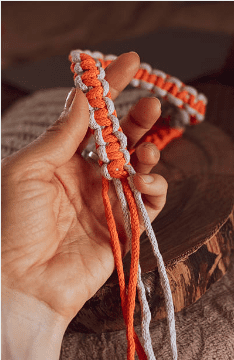
You’ll need about 8–10 ft of 550 paracord for a standard cobra weave on an 8" wrist (plan ~1 ft per finished inch), a plastic or metal buckle, a lighter to fuse ends, sharp scissors or a knife for cutting, a tape measure, and an optional fid or small screwdriver to weave tight knots. Test the buckle and cord; 550 paracord is rated ~550 lbs, which makes the bracelet both practical and strong.
| 550 paracord (8–10 ft) | Primary cord; ~1 ft per finished inch for cobra weave |
| Buckle or shackle | Closure and anchor point |
| Lighter | Fuse melted ends to prevent fray |
| Scissors/knife | Cut the cord; use carefully |
| Tape measure | Measure wrist and cord length |
| Fid/screwdriver (optional) | Help pull and tighten knots |
Step-by-Step Instructions
Measure your wrist plus 1" for comfort, then cut the cord to length (about 8–10 ft for an 8" wrist). Attach the cord to one buckle side with a cow hitch, set the other buckle at the measured length, and form cobra knots working from one side to the other. Trim excess, melt ends with the lighter and press into the weave, then test fit and tension for a secure, wearable bracelet.
Step Breakdown| Step 1: Measure | Wrist + 1" for comfort; note finished length |
| Step 2: Prep cord | Cut ~1 ft per finished inch; melt ends slightly |
| Step 3: Attach | Use a cow hitch or loop to anchor to the buckle |
| Step 4: Weave | Make cobra knots until the length is reached |
| Step 5: Finish | Trim, melt ends, tuck into weave, test fit |
For variations, double the cord length for a king cobra or add a ferrocerium rod, whistle, or small blade to the inner core for extra utility. Adjust knot tension so the weave lies flat without compressing the core; loose knots can catch, tight knots reduce flexibility. Practice on a 4–6" sample first to gauge cord usage, and always use the lighter cautiously—work over a nonflammable surface and secure melted ends firmly into the weave for a clean, durable finish.
Benefits of Wearing a Survival Paracord Bracelet
Wearing a survival paracord bracelet gives you a compact, always-available toolkit: most designs store 8–12 feet of Type III paracord with 550 lb tensile strength, plus the bracelet’s 7 inner strands for finer tasks. You keep repair material, improvised cordage, and emergency gear on your wrist without extra bulk, making quick fixes, gear lashings, and improvised tools far more likely to succeed during a stressful situation.
Accessibility and Convenience
You carry around several meters of usable cord without changing your loadout; typical bracelets weigh under an ounce and sit discreetly on your wrist, so you don’t have to rummage for gear. Fast deployment takes seconds: bite, pull, and unweave to free the outer sheath and inner strands. That speed matters for shelter lashing, emergency repairs, or creating improvised tourniquets in time-sensitive scenarios.
Versatility in Survival Situations
You can use the main sheath for heavy tasks like tying poles and the inner 7 strands for fishing line, sewing, or snares. A single bracelet supports shelter construction, gear repair, trap setup, and improvised shoelaces; different weaves produce varying lengths—cobra weaves often yield ~10 feet, while compact tactical braids can exceed 20+ feet for extended needs.
Unraveling the bracelet provides layered options: outer cordage for strong bindings and inner strands for precision work such as stitching fabric, replacing shoelaces, or fashioning fishing leaders. Field reports and survival guides note successful use for shelter lashing, gear repair, and emergency cordage; however, the inner strands are non-sterile, so medical uses like suturing or applying a tourniquet carry significant risk and should be approached with caution.
Care and Maintenance
You should inspect your bracelet every 3–6 months and after heavy exposure to rain, saltwater, or fuel; check for fraying, loose knots, worn buckles, and any core strand damage. Routine cleaning and proper storage extend usable life and preserve tensile strength; replace the bracelet if core fibers show degradation or if hardware no longer locks securely.
Cleaning Tips
You can wash nylon paracord with warm (30–40°C) water and mild soap, using a soft brush to remove grime; avoid bleach and high heat that degrade fibers.
- Rinse thoroughly and air-dry away from direct sunlight.
- Use mild soap only; never soak in chlorine bleach.
- Trim frayed ends and melt lightly with a lighter to secure cordage.
- Inspect buckles and knots for wear before packing.
This preserves the strength of the paracord and keeps your survival bracelet reliable.
Storage Recommendations
Store your bracelet in a cool, dry place—aim for 10–25°C and relative humidity under 60%—and avoid prolonged direct sunlight, which fades color and weakens fibers; keep it uncompressed in a fabric pouch or sealed bag with a silica gel packet and inspect every 6 months for fraying or stiffness.
For kit placement, group the bracelet with similar textiles and keep metal buckles separated from damp items to prevent corrosion—use a small plastic divider if needed. If you expect storage beyond a year, rotate items and air them every few months to prevent mildew. Avoid contact with gasoline, solvents, or fertilizers, which can severely weaken nylon fibers; if exposure occurs, wash immediately with warm water and mild soap, then test the cordage and hardware before relying on it in the field.
Final Words
So a survival paracord bracelet is a wearable coil of 550 paracord you can unravel for rope, shelter, splints, snares, or repairs; you make one by measuring your wrist, cutting 8–12 feet of cord, attaching a buckle or knot, and weaving a cobra (or other) stitch around a core cord, then securing the ends with a tight knot or melted finish; with basic tools and practice you build a compact, reliable emergency kit you can carry every day.
FAQ
A: A survival paracord bracelet is a wearable length of nylon parachute cord (commonly 550 paracord) woven into a bracelet. It stores several feet of strong, lightweight cord in a compact form so you can quickly unbundle it for emergency uses such as shelter building, lashing, first aid, or fishing line (inner strands).
A: A common rule of thumb for the standard cobra weave (using one cord folded in half) is about 1 foot (30 cm) of paracord per inch (2.5 cm) of finished bracelet length. Example: a 7‑inch bracelet needs roughly 7 ft (≈2.1 m) of cord. Measure wrist circumference, add about 1/2–1 inch (1.3–2.5 cm) for a comfortable fit, then apply the length rule. If you use two separate cords rather than one folded cord, you'll need roughly double the cord length.
A: Inspect the bracelet for wear, cuts, or UV degradation and replace if integrity is compromised. Do not use paracord bracelet cordage for certified life‑safety applications, such as climbing or hoisting people, unless the cord is specifically rated and used with proper gear. Keep away from open flames when in use and avoid overloading paracord beyond its rated strength.
A: Basic materials: 550 paracord (single color or multiple), a side‑release buckle or metal clasp, and optionally a small length of inner cord for decoration. Tools: scissors or a sharp knife, a lighter to melt ends, a tape measure or ruler, and optionally a fid, safety pin, or clamp to hold the strands while weaving.
A: Unraveled paracord and its inner strands serve many tasks: building or repairing shelters, making snares or fishing lines (inner strands), securing gear, creating tourniquets or splints, replacing bootlaces, making bow drills for fire, and lashing tools. The outer sheath is good for general cordage; inner strands are finer and useful for sewing, fishing, or tying small items.


